1 Overview
With the continuous progress of the national economy and the ever-increasing level of people's living standards, society has become increasingly demanding of the environment. Natural gas is increasingly favored by the general public as a clean energy source; natural gas is used as a fuel for public and private vehicles, in addition to the daily use of natural gas for residents and daily production of gas for enterprises. According to different production processes and technical processing methods, they are mainly divided into LNG (liquified natural gas) liquid natural gas and CNG (compressed natural gas) compressed natural gas.
The LNG/CNG refueling station network management system makes full use of modern high-tech technology, integrates modern IC card, electronics, network and database technology, and provides a convenient, stable, and quick resource sharing platform for the unified management of gas stations. The system is divided into two major systems: station level and center level.
Station-level management system: Data collection and monitoring of station-level equipment. Contains equipment layers (compressors, dryers, sensors, flow meters, dispensers, etc.), data acquisition and transmission layers, and monitoring management. Realize the monitoring of production data and equipment of this station, alarm/event information recording, refueling data management, and video monitoring.
Center-level management system: Consolidate production data and business data of multiple gas stations, and monitor the production data, alarm information, event records, and video images of each station. And to achieve data interconnection between stations to achieve inter-station intermodal capacity.
2 Product Features
Force Control Technology provides an extremely flexible, maintainable and safe LNG/CNG network management software platform. This software architecture can connect automation systems, gas stations, mainstream automatic control equipment (RTU), PLC, DCS, etc. The station automatic control system is equipped with professional graphic elements, expert analysis reports, trend analysis, event and alarm statistics modules.
Change online
Once installed, the system can make changes to the system online without affecting current operations or production tasks.
Remote deployment
Operators with the appropriate permissions can centrally manage and remotely deploy applications anywhere.
Remote monitoring
With the web-based functionality provided by Force Control, remote users can securely access force-controlled engineering screens using just the browser.
Extended performance
Can add gas station equipment and systems at will, while continuing to maintain early engineering work, from dozens of IO to tens of thousands of IO, from a single node to hundreds of workstations, force control technology can always meet the needs of the system.
safety
Force Control Technology has always maintained a powerful function in terms of security. It can uniformly deploy user rights in automated processes to ensure data access security, and at the same time provides security isolation suitable for the needs of the city gas industry in order to prevent attacks such as hackers and malicious code. Gateway.
Data collection and analysis
Force Control's SCADA software platform can be used for automatic data collection, storage and monitoring, can store multi-year data for each process point online, and provides a calculation engine tool that enables secondary calculations and advanced statistical analysis of data .
Report Tool
Force Control Software can quickly and easily create, print, and save hourly, daily, weekly, and monthly reports that include the minimum, maximum, and average values ​​for all time ranges, making it easy to see how each company is performing.
Rich communication interface
Force Control Technology provides a choice of more than 3,000 device protocols in the industry, and provides customized services for special proprietary protocols, supporting communication with field devices through dial-up, radio stations, Ethernet, microwave, mobile GPRS, CDMA, and other methods.
system integration
It supports secondary development functions such as OPC, ODBC, REAL-SQL, etc. The open interface can enable the force-controlled product to be integrated into any third-party system, application program or database, such as GIS, video linkage and other platforms.
Alarm management
After the gas station's alarm limit is modified, it can be synchronized to the dispatch center without operation. At the same time, alarm notification methods such as voice, telephone, mail, and short message can be implemented through simple configuration, so that real-time alarm information can be easily obtained.
Visual operation
Force Control Technology provides a wealth of drawing tools, gallery files and components. With simple configuration, users can quickly build images and connect real-time information and display. Applications can be viewed through a monitor or multiple screens.
3 Overall system introduction
3.1 LNG/CNG Station Control System
The LNG/CNG station control system can monitor and control the operation data of compressors, measuring equipment, dehydration purification devices, and gas sales machines in real time. It can be used to understand the operation conditions and safety conditions of field devices in real time, and can provide alarms in case of system emergency. And chain control provides safe protection for the efficient production of gas in the station.
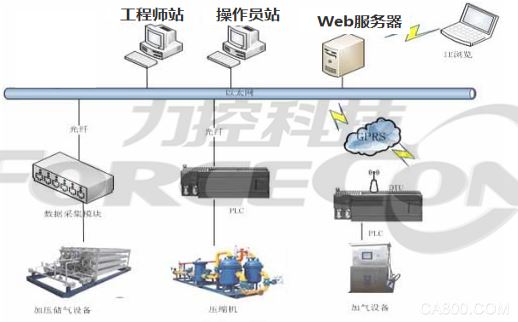
The main functions are as follows:
Monitoring process
Monitoring process parameters
Monitoring process equipment status
Monitor gas leak status
Report query and print export
Alarm management
record
Trend curve
authority management
Web publishing
Reserve interfaces for central and third-party programs
product model:
Site-controlled acquisition SCADA chooses the force-controlled eForceCon platform to collect and store data, deploy it in a redundant manner, and avoid data loss.
The engineer station uses force-controlled remote deployment tools to implement a single unified deployment.
The operator station uses the graphic client of the eForceCon platform and is responsible for the presentation of data and chart analysis.
3.2 Center System Introduction
The central system realizes the remote control of all LNG stations and CNG stations; it monitors and controls the production equipment of gas stations, and also establishes gas sales management servers to realize the networking of operations at each site.
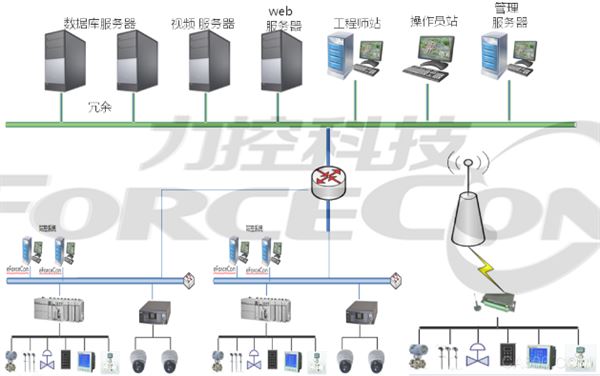
The main functions are as follows:
System parameter settings
Real-time production data collection
Real-time acquisition of refueling data
Transition management
Report query/print/export
Gas statistics analysis
product model:
The SCADA acquisition server software uses the force-controlled eForceCon platform to collect and store data and deploy it in a redundant manner to avoid data loss.
The engineer station uses force-controlled remote deployment tools to implement a single unified deployment.
The operator station adopts the graphic client of the eForceCon platform and is responsible for the display of data, chart analysis, and online operation and maintenance.
The WEB publishing platform adopts a force-controlled integrated publishing platform to support online browsing of production networks.
4 system function
4.1 Real-time production data monitoring and control
The system is transmitted to the monitoring interface through the real-time database platform. The data information (pressure, temperature, flow rate, and our state, etc.) of each monitoring point is displayed in real time, and real-time control of the compressor, dryer, valve, etc. is performed.
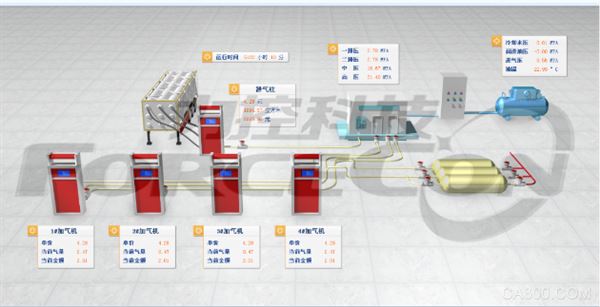
4.2 Dynamic Display Process
Using real-time monitoring of production data and powerful software drawing tools, according to the user's requirements, they can draw 3D dynamic process flow pictures as they like, and visualize the entire process flow on the computer. You can see the relevant switch quantity, the running/stop of the equipment, and the real-time changes of the analog quantity. The foreground color, the background color and the dynamic moving direction of the target of the graphic target can be arbitrarily specified and can be dynamically changed.

4.3 Real-time and historical data trends, bar graph display
Historical trends: According to the needs of users, we can generate historical trend charts for the relevant monitoring point data. Through the historical trend, the user can view historical graph records of a specific section (point) time before, and can find the time when the fault occurs and the trend of change, so as to find the cause of the system fault.
Real-time trend: Real-time trend graphs can also be generated to analyze the changing trend of analog parameters (such as flow, temperature, pressure, etc.) to better allow operators to grasp the trend of system parameters and keep the system running optimally.
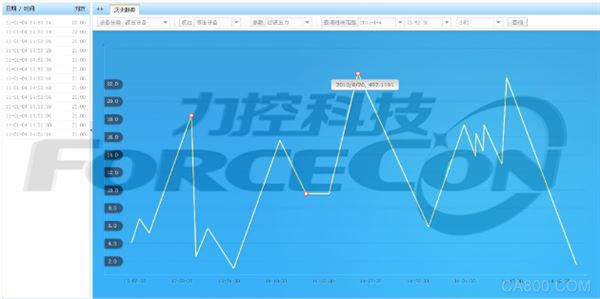
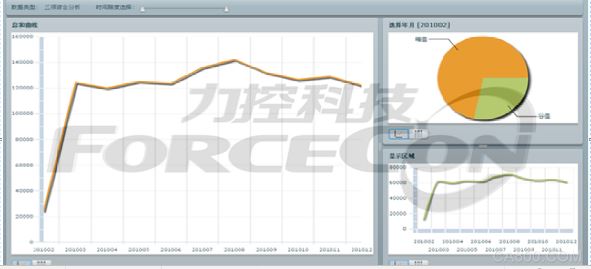
4.4 Alarm and Event Management
For monitoring station equipment or system components fault alarms, diagnostic alarms, etc., management software can automatically handle. After the alarm configuration is performed on the process alarm management software, it is automatically processed. For any alarm, the system can use the built-in speaker of the monitoring station to sound an alarm, or use the important parameter alarm to be output to a digital output point when the alarm occurs to drive an external sound. For each alarm, you can configure the system to automatically switch to the alarm parameter screen when the alarm occurs. At the same time, the alarm information is displayed in a bold color on the alarm prompt line.
Each alarm can be configured whether to print and print styles, the alarms displayed on the workstation are all with date and time, and the date and time of alarm parameter recovery are also displayed and recorded. The method configured for each alarm type is done in the alarm configuration dialog box. Alarm and print time resolution up to 1 second.
The details of the alarm are as follows:
The alarms/events have priority to display. In addition to the single point display in the process, the alarm or event status list is displayed. The table includes at least the identifier (digit), value, description, time (year, month, day, hour, Minutes, seconds), location, etc.
The alarm has an easy-to-vibrate sound output and has a voice prompt function; the alarm display can be suppressed or eliminated by the operator; a warning and danger secondary alarm should be given to the process variable over-limit value.
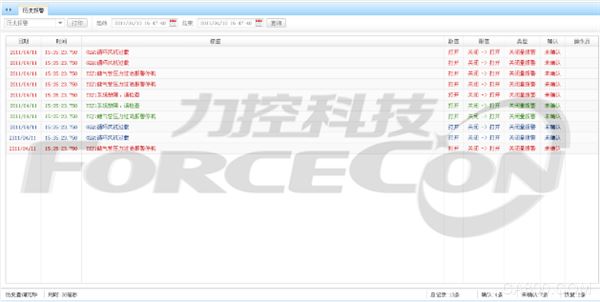
4.5 Report Generation and Printing
The report format can be based on the actual requirements of production, through the dynamic link of monitoring software and EXCEL spreadsheets, arbitrarily define various forms and formats, such as class reports, daily reports, monthly statistics, and even annual statistics. And can calculate the maximum and minimum value of each report, and make corresponding data analysis plans such as bar graphs, trend graphs, and X-bar graphs, so that the entire pipeline network operation, equipment optimization, and enterprise management can enter a comprehensive quantitative control process. Using the scheduled print settings feature, you can set up automatic printing of various types of reports at regular intervals. You can also manually intervene as needed to print the required reports at any time.
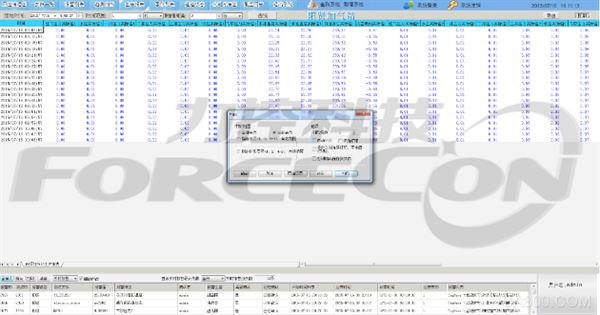
4.6 Web Publishing and Mobile Office
IE can monitor real-time data, inquire historical data, browse real-time data and pipe network information through smart phones, complete meter reading, and browse system video through 3G and 4G networks.

4.7 Video Surveillance System
The video surveillance system consists of a central monitoring system, a video surveillance system for a station library, transmission equipment, and a central equipment (video workstation). It is mainly used for security monitoring and equipment monitoring. The SCADA system supports integration with video surveillance systems and completes alarm linkage.
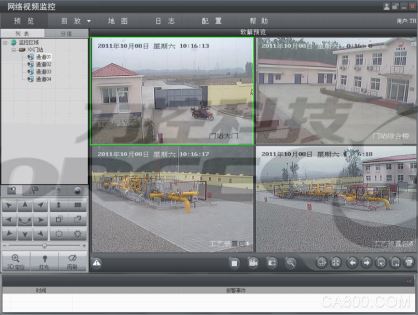
All in One Solar Street Light,Integrated Solar Street Lamp,Solar Street Light Outdoors
Jiangsu Bosiwei Optoelectronics Group Co.,ltd , https://www.bswledled.com